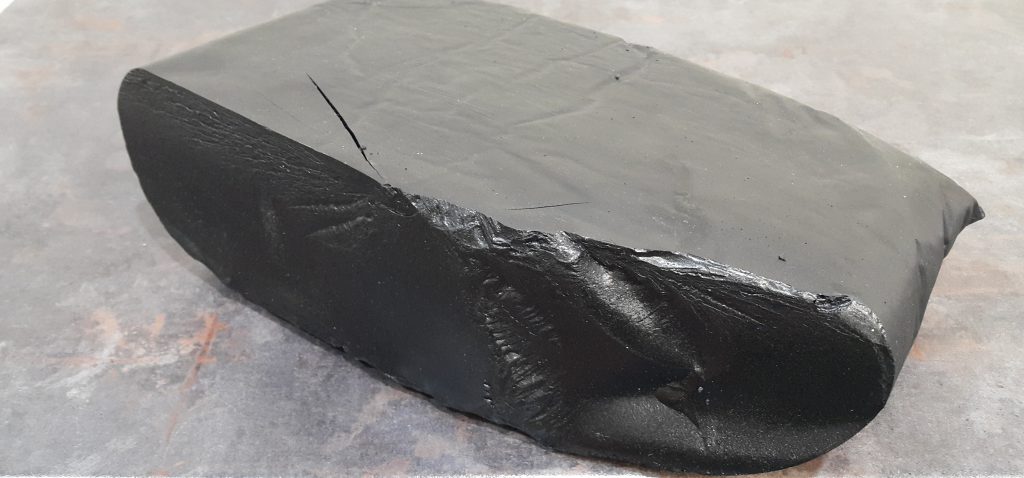Oxidized Bitumen
Oxidized Bitumen Description

Blown bitumen grade or Oxidized Bitumen are produced by passing air through the penetration grades. This process gives the bitumen more rubbery properties than its original formula and they are simply harder bitumen. Hard bitumen under controlled temperature conditions is widely used as an anti-slip layer compound in the piling industry, for manufacture of roofing felts, the roofing and waterproofing industries, for sound dampening felts and under carriage sealant in the automotive industry, electric cable joint protection, joint filling compound, sealant compound and many others. Also used in sealing saw cuts and joints where expected movements are minimum. It is also used in the manufacturing of bituminous marine mastic for the oil & gas pipeline joints.
The most popular grades are; 95/25, 85/35, 90/40 and 115/15. We are also capable of producing other grades of Blown Bitumen upon request by our customers. Blown Bitumen high softening temperatures qualify them as excellent sealant for prevention from bleeding in high temperature applications. Blown Grade Bitumen shall be broken up into small pieces (for blown grade in molded cake form) and heated slowly to the application temperature of 220ºC to 230ºC. blown Bitumen is predominantly used in the piling industry as an anti slip compound for the manufacture of under carriage sealants in the automobile industry. It is also used as a sealant compound, as a joint filling compound apart from being used in the manufacture of roofing felts and sound dampening felts. Further, Blown Bitumen is used in the manufacture of bituminous marine mastic, which is required for the oil and gas pipeline joints. blown Bitumen is available in different grades like 95/25, 85/25, 75/25, 90/40 and 115/15. Tavoil is also capable of producing other grades of Oxidized Bitumen according to the specifications of individual clients.
Oxidized Bitumen Characteristics
Some of the major advantages of Oxidized Bitumen are that it is completely water resistant, highly flexible and durable. Further, it is chemically very stable. blown bitumen is a very flexible compound that is not only chemically stable but also a very durable compound apart from being completely water resistant. Lastly, Blown Bitumen has some very prominent technical advantages that makes it a very sought after compound in various applications.
Blown Bitumen Applications
Oxidized bitumens are used almost entirely for industrial applications, eg roofing, flooring mastics, pipe coatings, paints, etc, and are specified and designated by both softening point and penetration tests.
• Used As a bonding bitumen for roofing sheet membranes.
• Used As a hot-applied waterproofing layer.
• Used in Carpet tile manufacture.
• Used As a raw material for liquid bitumen coatings.
• Used in production of bituminous paint, mastic.
• Used in rust proof pipe coatings.
• Used as an anti-slip layer compound in the piling industry.
• Used in production of roofing and sound dampening felts.
• Used as under carriage sealant in the automobile industry, electric cable joint protection, joint filling compound, sealant compound and much more in our day to day life.
We are also capable of producing other grades of Blown Bitumen upon request by our customers. Oxidized Bitumen high softening temperatures qualify them as the excellent sealant for prevention from bleeding in high-temperature applications. Blown Grade Bitumen shall be broken up into small pieces (for the blown grade in molded cake form) and heated slowly to the application temperature of 220ºC to 230ºC. Oxidized Bitumen is predominantly used in the piling industry as an anti-slip compound for the manufacture of undercarriage sealants in the automobile industry. It is also used as a sealant compound, as a joint filling compound apart from being used in the manufacture of roofing felts and sound dampening felts. Further, Oxidized Bitumen is used in the manufacture of bituminous marine mastic, which is required for the oil and gas pipeline joints. This Oxidized Bitumen is available in different grades like 95/25, 85/25, 75/25, 90/40 and 115/15. Oxidized is also capable of producing other grades of Oxidized Bitumen according to the specifications of individual clients
Oxidized Bitumen Grades are suitable for sealing saw cuts and joints where there is expected to be the minimum amount of moving in the joint. Their wide temperature range prevents bleeding in high-temperature applications. Oxidized bitumen can also be used in industrial applications like roofing, flooring, mastics, pipe coatings, electrical applications to name a few.
Oxidised bitumen ” Oxidized Bitumen, Oxidized Asphalt ” range is used in the waterproofing industries, for carpet-backing, corrosion protection, acoustic panels and the manufacture of paints, amongst other applications.
Air-blowing: The manufacturing process used to make oxidized roofing asphalts in which air is blown through an asphalt flux. An exothermic oxidation reaction occurs, yielding an asphalt that is harder, more viscous, less volatile, and less temperature-susceptible than the asphalt flux used as the feedstock to the process.
Asphalt, oxidized (blown or air-refined) (CAS number 64742–93–4): Asphalt treated by blowing air through it at elevated temperatures to produce physical properties required for the industrial use of the final product. Oxidized asphalts are used in roofing operations, pipe coating, undersealing for Portland cement concrete pavements, hydraulic applications, membrane envelopes, some paving-grade mixes [AI 1990b], and the manufacture of paints [Speight 1992].
Blowing still: A closed-process vessel fitted at its base with a sparger and used in the air-blowing process to make many types of roofing asphalt.
Coating asphalt: An air-blown or oxidized asphalt used to manufacture roofing materials used in a variety of roofing systems such as asphalt shingles, polymer-modified bitumen roofing, reinforcing and underlayment felts, and roll roofing products.
Modified bitumen: A roofing system based on membranes manufactured by impregnating or coating one or more fabric plies with a straight-run or oxidized asphalt modified using a polymer, usually atactic polypropylene (APP) or styrene-butadiene-styrene (SBS). Modified bitumen systems may be torch-applied or installed by adhesion in hot asphalt or a cold-applied, solvent-based asphalt adhesive (cutback asphalt). Modified bitumen systems are used on low-slope (primarily commercial or industrial) roofs.
